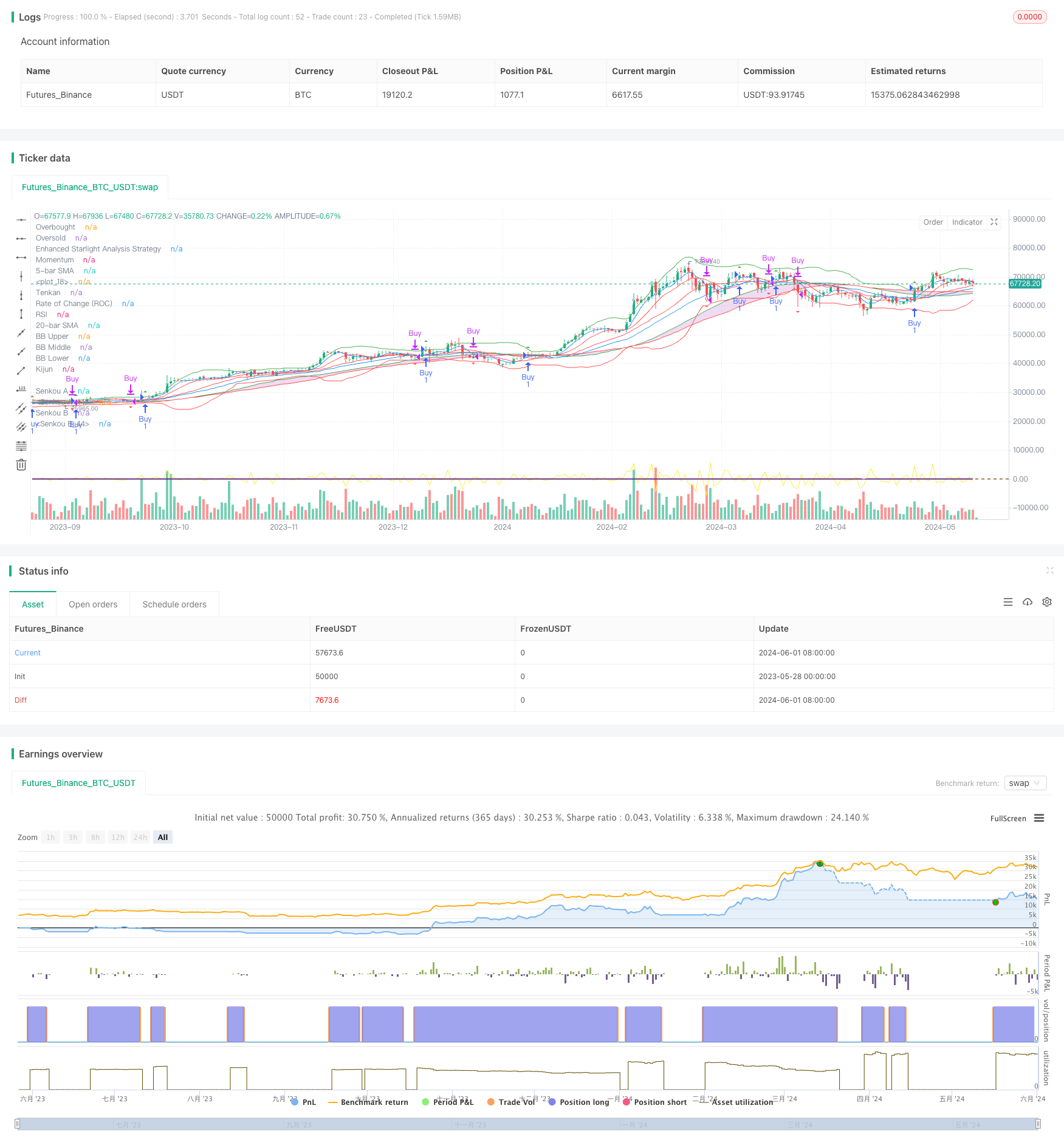
概述
移动平均聚合动量云策略是一个综合性的交易策略,旨在通过结合多个技术指标来为趋势和区间市场条件提供强大的信号。该策略集成了移动平均线、布林带、相对强弱指数(RSI)和一目云,为市场动态提供全面视角,帮助交易者做出明智决策。
该策略使用短期移动平均线(5周期SMA)和长期移动平均线(20周期SMA)来识别价格趋势。当短期移动平均线穿过长期移动平均线上方时,会产生买入信号;反之则产生卖出信号。布林带用于衡量市场波动性,识别潜在的超买和超卖状态。RSI指标用于判断市场的动能和潜在的反转点。一目云提供对支撑位和阻力位、趋势方向以及未来可能的价格走势的洞察。策略还计算动量和变化率(ROC)指标,以进一步分析市场趋势的强度。
策略原理
移动平均聚合动量云策略的核心原理是结合多个技术指标,以全面评估市场状况。通过分析价格与移动平均线的关系,策略可以确定当前的趋势方向。短期移动平均线穿越长期移动平均线被视为趋势反转的信号。布林带通过测量价格相对于统计波动的偏离程度,提供对市场波动性的洞察。RSI指标揭示了市场的动能状况,有助于识别潜在的超买和超卖水平。一目云结合了多个移动平均线,形成一个云状区域,提供对支撑位、阻力位和未来价格走势的见解。动量和ROC指标进一步量化了价格变化的速度和强度。通过综合考虑所有这些指标,该策略旨在产生可靠和及时的交易信号。
策略优势
移动平均聚合动量云策略的主要优势在于其多维度的市场分析方法。通过结合移动平均线、布林带、RSI和一目云等多个指标,该策略能够全面评估市场状况,提供更可靠的交易信号。移动平均线交叉可以有效识别趋势的变化,而布林带和RSI则有助于确定潜在的进场和出场点。一目云提供了一个直观的视角,展示了价格与关键支撑位和阻力位之间的关系。此外,动量和ROC指标可以量化价格变化的速度和强度,帮助交易者评估趋势的可持续性。总的来说,通过综合运用这些指标,移动平均聚合动量云策略能够适应不同的市场条件,为交易者提供全面而深入的市场洞察。
策略风险
尽管移动平均聚合动量云策略具有多个优势,但它也存在一些潜在的风险。首先,该策略依赖于多个技术指标,这可能导致信号冲突或误导性信号。例如,在趋势不明朗或市场波动加剧的情况下,不同指标可能会产生相互矛盾的信号。其次,该策略主要基于历史数据,可能无法充分考虑突发事件或基本面变化对市场的影响。此外,过度优化参数设置可能导致策略在未来市场条件下表现不佳。为了缓解这些风险,交易者应谨慎选择参数,并定期评估和调整策略。同时,将该策略与其他分析方法相结合,如基本面分析和风险管理技术,可以提高其可靠性和稳健性。
策略优化方向
移动平均聚合动量云策略可以通过几个方面进行优化,以提高其性能和适应性。首先,可以对各个指标的参数进行优化,如调整移动平均线的周期、布林带的标准差倍数或RSI的超买/超卖阈值。通过对不同市场条件和资产类别进行回测,可以找到最佳的参数组合。其次,可以引入其他技术指标或市场情绪指标,以增强策略的信号生成能力。例如,将成交量指标或市场波动率指标纳入考量,可以提供额外的见解。此外,应用机器学习算法或自适应逻辑可以帮助策略动态调整参数,以适应不断变化的市场环境。最后,将该策略与风险管理技术相结合,如设置适当的止损和止盈水平,可以帮助限制潜在损失并保护利润。
总结
移动平均聚合动量云策略是一个功能强大且全面的交易方法,它结合了多个技术指标,以评估市场趋势、动量和波动性。通过分析移动平均线交叉、布林带、RSI和一目云等指标,该策略能够生成可靠的交易信号,并适应不同的市场状况。尽管该策略有其优势,但交易者也应意识到潜在的风险,如信号冲突和过度优化的可能性。为了提高策略的性能,可以探索参数优化、纳入其他指标、应用自适应逻辑以及结合风险管理技术等方面。总的来说,移动平均聚合动量云策略为交易者提供了一个强大的工具,通过综合分析多个技术指标,帮助他们做出明智的交易决策。
/*backtest
start: 2023-05-28 00:00:00
end: 2024-06-02 00:00:00
period: 1d
basePeriod: 1h
exchanges: [{"eid":"Futures_Binance","currency":"BTC_USDT"}]
*/
//@version=5
strategy("Enhanced Starlight Analysis Strategy", overlay=true)
// Inputs for moving averages
shortLength = input.int(5, title="Short Moving Average Length")
longLength = input.int(20, title="Long Moving Average Length")
// Calculate moving averages
ma1 = ta.sma(close, shortLength)
ma2 = ta.sma(close, longLength)
// Determine the fill color based on the relationship between ma1 and ma2
fillColor = ma1 > ma2 ? color.new(color.green, 90) : color.new(color.red, 90)
// Plot the moving averages and fill the space between them
plot(ma1, "5-bar SMA", color=color.blue)
plot(ma2, "20-bar SMA", color=color.orange)
fill(plot(ma1), plot(ma2), fillColor, "SMA plot fill")
// Additional Analysis: Bollinger Bands
bbLength = input.int(20, title="BB Length")
bbMult = input.float(2.0, title="BB Multiplier")
[bbUpper, bbMiddle, bbLower] = ta.bb(close, bbLength, bbMult)
plot(bbUpper, color=color.red, title="BB Upper")
plot(bbMiddle, color=color.green, title="BB Middle")
plot(bbLower, color=color.red, title="BB Lower")
// Additional Analysis: RSI
rsiLength = input.int(14, title="RSI Length")
rsi = ta.rsi(close, rsiLength)
plot(rsi, color=color.purple, title="RSI")
hline(70, "Overbought", color=color.red)
hline(30, "Oversold", color=color.green)
// Ichimoku Cloud
tenkan = ta.sma((high + low) / 2, 9)
kijun = ta.sma((high + low) / 2, 26)
senkouA = ta.sma((tenkan + kijun) / 2, 26)
senkouB = ta.sma((high + low) / 2, 52)
plot(tenkan, color=color.red, title="Tenkan")
plot(kijun, color=color.blue, title="Kijun")
plot(senkouA, color=color.green, title="Senkou A")
plot(senkouB, color=color.red, title="Senkou B")
fill(plot(senkouA, "Senkou A", color=color.green), plot(senkouB, "Senkou B", color=color.red), color.new(color.purple, 80), title="Kumo (Cloud)")
// Signals and Alerts
crossAbove = ta.crossover(ma1, ma2)
crossBelow = ta.crossunder(ma1, ma2)
plotshape(series=crossAbove, location=location.abovebar, color=color.green, style=shape.triangleup, title="Buy Signal")
plotshape(series=crossBelow, location=location.belowbar, color=color.red, style=shape.triangledown, title="Sell Signal")
alertcondition(crossAbove, title="Buy Alert", message="MA1 has crossed above MA2 - Buy Signal")
alertcondition(crossBelow, title="Sell Alert", message="MA1 has crossed below MA2 - Sell Signal")
// Strategy Logic: Execute Buy and Sell Orders
if (crossAbove)
strategy.entry("Buy", strategy.long)
if (crossBelow)
strategy.close("Buy")
// Equations for Further Analysis
// Example: Calculating Momentum
momentum = close - close[1]
plot(momentum, color=color.yellow, title="Momentum")
// Example: Calculating Rate of Change (ROC)
rocLength = input.int(12, title="ROC Length")
roc = (close - close[rocLength]) / close[rocLength] * 100
plot(roc, color=color.black, title="Rate of Change (ROC)")
// Display Summary Label
var label summaryLabel = label.new(x=bar_index, y=na, text="", xloc=xloc.bar_index, yloc=yloc.price, color=color.green, textcolor=color.white, size=size.small)
if (bar_index % 10 == 0) // Update label every 10 bars
label.set_xy(summaryLabel, bar_index, high)
label.set_text(summaryLabel, "Short MA: " + str.tostring(ma1) + "\nLong MA: " + str.tostring(ma2) + "\nRSI: " + str.tostring(rsi) + "\nMomentum: " + str.tostring(momentum) + "\nROC: " + str.tostring(roc))
// Plot title for the indicator
plot(close, title="Enhanced Starlight Analysis Strategy", color=color.white)